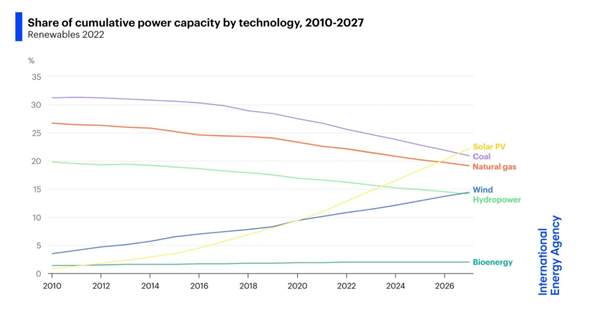5 reasons solar power can turbocharge the renewable energy market in 2023
As the cost-of-living crisis bites this winter, it’s clear that we need an alternative to the fluctuating prices of fossil fuels. One of the clearest lessons of 2022 was the importance of speeding up the transition to renewable energy in 2023.
The good news is that solar power is poised to put the world on a more optimistic path. In fact, as a result of falling costs and incentives around energy security, solar is not only expanding but set to overtake other energy sources by 2027.
The bright future of solar
 Amid the bleak headlines, renewable power is on the rise: that’s the message coming loud and clear from the International Energy Association.
Amid the bleak headlines, renewable power is on the rise: that’s the message coming loud and clear from the International Energy Association.
According to IEA’s latest research, global renewable power capacity is expected to grow by 2,400GW between 2022 and 2027 – equivalent to the entire power capacity of China today. This is 30% higher than the growth it forecast just a year ago.
Solar has a vital role to play in this transition. Global solar energy capacity is set to triple by 2027, surpassing coal to become the largest source of power in the world.
But to reach net zero by 2050, even this growth is not enough. We need a five-fold increase every year between now and 2030 to reach climate change goals.
Here are five reasons why large-scale, ground-mounted solar is a smart way to build a carbon-neutral energy system.
5 benefits of solar
1. Solar works with nature
Solar projects work alongside agriculture, not against it.
Farmers can send their livestock to graze safely amongst the photovoltaic panels, giving the animals uninhibited access to the plants beneath them and even providing pleasant shade during the hotter months.
It’s a win-win for farmers and the planet. Livestock grazing helps keep the soil healthy, providing a natural fertiliser while munching away invasive plant species. Farmers, meanwhile, gain a valuable additional income source and free access to productive land.
Sharing land in this way allows biodiversity, rural economies and clean energy to grow in harmony. That’s why we’re already taking this approach, from Wales to Pennsylvania.

2. Solar works with wind
The space-sharing benefits of solar doesn’t end with wildlife. Wind turbines can stand comfortably alongside solar panels, capitalising on two sources of energy at the same time. Turbines are tall and narrow so they don’t obstruct access to sunlight. Ground-mounted solar panels, meanwhile, are low down and secure, even in high winds.
As well as maximising the use of space, doubling-up on energy resources helps create a more resilient grid. Wind turbines provide more energy through the winter while solar farms are especially effective during the sunnier summer months, so combining them helps ensure a steady flow of power all year round.
3. Solar is cheaper
Clean energy isn’t just healthier for the planet than fossil fuels, it also makes economic sense. Solar power is not only more cost-effective than coal and oil but also natural gas, often touted as a cheaper alternative.
As the IEA’s research suggests, from December 2021 to October 2022, the average prices to carry out long-term wind and solar PV projects were 77% lower than wholesale gas market prices. And, as fossil fuels become scarcer, the price gap is only likely to widen.
4. Solar is scalable
Can solar power deliver on the massive scale our increasingly energy-hungry world needs? It’s another resounding yes!
Solar energy won’t run out – at least, not for another 5 billion years or so! Although we might not be planning quite that far into the future, we’re ready to scale up solar generation capacities today. It can be done far quicker and more safely than other methods. Not only this, but ground-mounted solar farms can be placed in unused, low-value spaces like poor-quality soil or deserts, as has been done in places like California.
In fact, we have the space to scale up the solar power we need many times over. Taking the United States as an example, the US Office of Energy Efficiency & Renewable Energy has calculated that putting solar PV panels on 22,000 square miles – an area around the size of Lake Michigan – would provide enough electricity to power the entire nation.
5. Solar is homegrown
In the current tumultuous climate, energy security is an increasingly important concern. Nowhere is this more apparent than in Europe, where energy bills have shot up as a direct result of natural gas shortages following the Russian invasion of Ukraine. As people struggle through a difficult winter, they’re calling for an expansion of domestic energy generation, to shield them from the drastic price fluctuations of the international energy market.
Once again, the advantages that home-grown, renewable energy can offer are clear to see. By investing in large-scale solar projects, countries can avoid being held to ransom by geopolitical crises. This, in turn, gives them a more diverse energy mix, helping to maintain a reliable source of power.
Investing in solar PV projects can help deliver immediate, tangible benefits. And, if we are to meet the targets recommended by the IEA, it’s vital that we expand our solar ambitions today to build a carbon neutral tomorrow.
Governments and business leaders are now beginning to set the pace – and 2023 looks like the year when the sun will shine on those who procure solar power.
Find out more about renewable power
To find out more, visit our buy renewable power page.
Read more
02 Apr, 2025
Lightsource bp contributes to the World Economic Forum’s conversation on responsible renewables deployment practices
Lightsource bp’s Penny Laurenson, Global Head of Sustainability, contributed to WEF’s conversation and thought leadership on responsible deployment practices.
19 Feb, 2025
10 Power Purchase Agreements signed and 1.3GW contracted in 2024
Lightsource bp achieved a significant milestone in 2024 by securing 10 power purchase agreements (PPAs) totalling 1.3GW across Europe, the Americas and APAC.
24 Oct, 2024
bp completes acquisition of Lightsource bp
bp has completed its acquisition of the remaining 50.03% interest in Lightsource bp.




